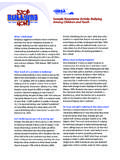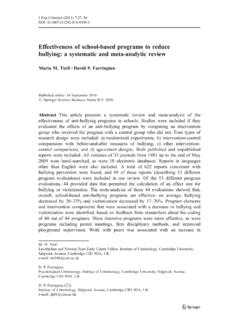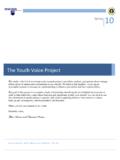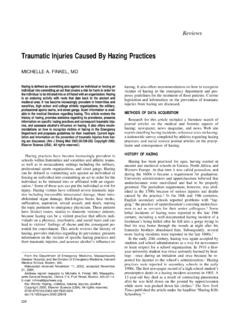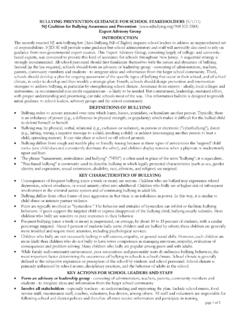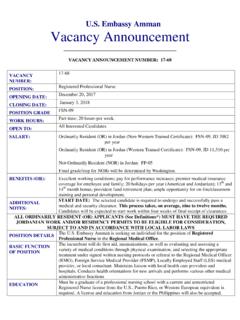Transcription of Aggression and Violent Behavior
1 Aggression and Violent Behavior 15 (2010) 112 120. Contents lists available at ScienceDirect Aggression and Violent Behavior Bullying and the peer group: A review Christina Salmivalli . University of Turku, Finland University of Stavanger, Norway a r t i c l e i n f o a b s t r a c t Article history: It is often stated that bullying is a group process , and many researchers and policymakers share the belief Received 15 June 2009 that interventions against bullying should be targeted at the peer-group level rather than at individual Received in revised form 26 August 2009 bullies and victims. There is less insight into what in the group level should be changed and how, as the Accepted 28 August 2009. group processes taking place at the level of the peer clusters or school classes have not been much Available online 6 September 2009. elaborated. This paper reviews the literature on the group involvement in bullying, thus providing insight into the individuals' motives for participation in bullying, the persistence of bullying, and the adjustment of Keywords: Bullying victims across different peer contexts.
2 Interventions targeting the peer group are brie y discussed and future Victimization directions for research on peer processes in bullying are suggested. Participant roles 2009 Elsevier Ltd. All rights reserved. Peer group Classroom context Contents 1. What does the bully want? .. 113. 2. Peer involvement during bullying incidents: participant roles .. 114. 3. Why don't peers intervene more often? .. 115. 4. Individual differences .. 115. 5. Peer clusters and involvement in bullying .. 116. 6. Classroom effects .. 116. 7. To be the target of bullying: classroom effects on adjustment .. 117. 8. Implications for bullying interventions .. 117. 9. Conclusions and future directions .. 118. Acknowledgment .. 118. References .. 118. Bullying is a subtype of aggressive Behavior , in which an individual the concept of bullying is used to refer to peer-to-peer bullying among or a group of individuals repeatedly attacks, humiliates, and/or school-aged children and youth, when not otherwise mentioned.
3 Excludes a relatively powerless person. The majority of studies on It is known that a sizable minority of primary and secondary school the topic have been conducted in schools, focusing on bullying among students is involved in peer-to-peer bullying either as perpetrators or children and youth (Boulton & Smith, 1994; Olweus, 1978; Salmivalli, victims or as both, being both bullied themselves and harassing others. Lagerspetz, Bj rkqvist, sterman, & Kaukiainen, 1996; Veenstra et al., In WHO's Health Behavior in School-Aged Children survey (HBSC, see 2005). Bullying has also been studied at kindergartens (Alsaker & Craig & Harel, 2004), the average prevalence of victims across the 35. N gele, 2008), workplaces (Bowling & Beehr, 2006; Nielsen, Matthie- countries involved was 11%, whereas bullies represented another 11%. sen, & Einarsen, 2008), in prisons (Ireland, 2005; Ireland, Archer, & Children who report both bullying others and being bullied by others Power, 2007; South & Wood, 2006), and at least in one study, in an (so-called bully victims) were not identi ed in the HBSC study, but army setting (Ostvik & Rudmin, 2001).
4 Throughout the present review, other studies have shown that approximately 4 6% of the children can be classi ed as bully victims (Haynie et al., 2001; Nansel et al., 2001). Department of Psychology, FI-20014 University of Turku, Finland. Bullying constitutes a serious risk for the psychosocial and E-mail address: . academic adjustment of both victims (Erath, Flanagan, & Bierman, 1359-1789/$ see front matter 2009 Elsevier Ltd. All rights reserved. C. Salmivalli / Aggression and Violent Behavior 15 (2010) 112 120 113. 2008; Hawker & Boulton, 2000; Isaacs, Hodges, & Salmivalli, 2008; (Keltner, Gruenfeld, & Anderson, 2003, p. 265). Furthermore, it is the Olweus, 1994; Salmivalli & Isaacs, 2005) and bullies (Kaltiala-Heino, group that assigns status to its members, so the bullies are dependent Rimpel , Rantanen, & Rimpel , 2000; Nansel et al., 2004). Besides on the peer group in the realization of their status goal. victims and their perpetrators, there is evidence that peers merely Children differ in the relative importance they attach to communal witnessing the attacks can be negatively in uenced (Nishina & (making friends, being prosocial, feeling close to others) and agentic Juvonen, 2005).
5 (being visible, in uential, and admired) goals. Self-perceived impor- Thinking of how the group is involved in bullying is in a way tance of agentic goals has been found to explain variation in proactive returning to the roots . The concept originally used in Scandinavian (but not reactive) Aggression (Salmivalli, Ojanen, Haanp , & Peets, languages to refer to bullying was mobbing (in Swedish, mobbning), 2005). Sitsema, Veenstra, Lindenberg, and Salmivalli (2009) found and the phenomenon was described as a group of children ganging up that the child's probability of being involved in a bullying relationship on one and the same victim, harassing and tormenting him/her as a bully was related to a high degree of status goals, especially among repeatedly. The term mob had been used even before to refer to adolescent males. The scale assessing status goals was a subscale of the unorganized, emotional, often antisocial and/or aggressive crowds agentic goals scale used by Salmivalli et al.
6 (2005), including three (see Lagerspetz, Bj rkqvist, Berts, & King, 1982). Thus, in the early items: (When with your peers, how important it is for you that) you writings on mobbing among school children, the idea of group appear self-con dent and make an impression on the others , the engagement was clearly present. Heinemann (1972), for instance, others think you are smart and the others respect and admire you . described mobbing as a situation in which the entire school class, or Bj rkqvist, Ekman, and Lagerspetz (1982) studied the ego picture, the majority of it, attacks an individual child. Olweus (1978, p. 5), on the ideal ego picture, and the normative ego picture of 14 16 year-old the other hand, stressed in his early book, the role of individual bullies adolescents. They found that bullies not only perceived themselves as and possibly subgroups of bullies, and warned about overemphasizing dominant (ego picture) but also had high ideals concerning the collective aspect of mobbing.
7 He suggested directing attention to dominance male bullies actually wanted to be even more dominant situations in which an individual child is exposed to Aggression than they already were (ideal ego picture). Furthermore, the bullies systematically and over time, whether from an individual, a small believed that others expected them to be dominant (normative ego group, or a whole class. picture). In a study conducted among adult (male) prisoners, South Today, group involvement in bullying is understood somewhat and Wood (2006) found that bullying was positively related to the differently than the whole group, or gang, actively attacking one perceived importance of social status and prestige, operationalized by person. The group members are seen as having different roles in the items such as It is important to me that other prisoners don't see me process, driven by diverse emotions, attitudes, and motivations. Their as weak , and One of the most important things in prison life is being individual characteristics interact with environmental factors, such as respected by other prisoners.
8 Classroom norms, contributing to the process which can have If bullying is driven by status goals, it should be more common tremendously hurtful outcomes for the targeted individual(s). Placing during periods in life when peer status is considered important. One bullying in its group context helps to better understand the such period is obviously adolescence ( , Eder, 1985; LaFontana &. individuals' motivation to bully, the lack of support provided to the Cillessen, 2009). In a recent study, LaFontana and Cillessen (2009). victims, the persistence of bullying, and the adjustment of victims showed a clear peak in prioritizing status enhancement in early across diverse contexts. Finally, the group view is helpful in developing adolescence, when one third of study participants chose status effective interventions against bullying. enhancement over friendship, and as many as 74 79% considered it more important than rule adherence. The expected increase in 1.
9 What does the bully want? bullying others during adolescence has been found in several studies ( , Espelage, Bosworth, & Simon, 2001; Pellegrini & Long, 2002;. In social groups where bullying takes place, initiative ringleader Scheithauer, Hayer, Petermann, & Jugert, 2006). It has been suggested, bullies can typically be identi ed. Their prevalence in child and however, that the developmental changes in prioritizing status and in adolescent samples is typically around 5 15% (Craig & Harel, 2004; bullying others might be quali ed by the transition to a new school. In K rn et al., in press; Pellegrini, Bartini, & Brooks, 1999). Early other words, the transition to middle/secondary school might explanations of bullies' Behavior emphasized their aggressive per- enhance the importance of peer acceptance, popularity, and tting sonality pattern (Olweus, 1978), which caused them to aggress in in the new social environment (Juvonen & Ho, 2009; Pellegrini, against several people in different contexts.)
10 Bullying Behavior was 2002) and consequently, bullying Behavior . However, a recently seen, as Aggression in general, rather stable over time and indepen- collected data set involving 195,000 Finnish students from all grade dent of social context. The early descriptions of bullies' personality levels of comprehensive education, , Grades 1 9 (Salmivalli and the ( , Olweus, 1978, p. 158 163) were not yet in uenced by the KiVa project, unpublished data collected in May 2009) shows that the nowadays commonly used taxonomy based on the functions of increase in bullying starts taking place already at the age of 12, , one aggressive Behavior , namely, the distinction between reactive and year before the transition (Grade 7 in Finland), rather than after it. proactive Aggression (Dodge, 1991). Bullying, which is typically This suggests increase in bullying is not due to the transition alone. unprovoked and deliberate, can be considered a subtype of proactive, If bullies want status, they should be likely to choose their victims, goal-directed Aggression (Coie, Dodge, Terry, & Wright, 1991).
